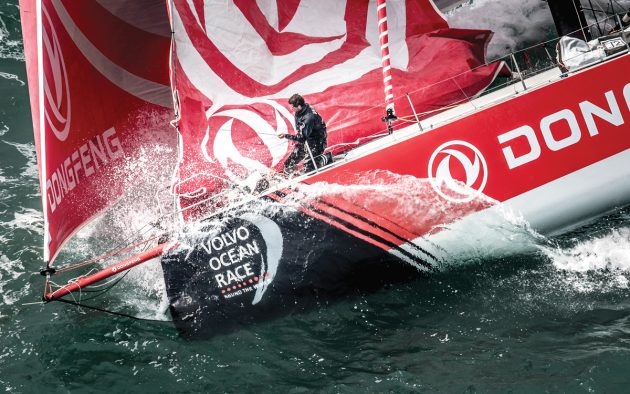Andy Rice talks to Volvo Ocean Race winning bowman Jack Bouttell to get his top tips for running the bow offshore
British-Aussie pro sailor Jack Bouttell believes that success in his job as bowman comes down to preparation more than anything else. This applies especially to inshore bowmen about to go offshore for a big race: if you try to wing it, and make it up as you go along, you’ll come unstuck.
A good bowman will find out as much as he can about the boat and the systems on board even before he has arrived at the marina. Training time is critical for planning and refining processes, especially working up a system of communications between the crew, as Bouttell found on the multilingual Dongfeng crew, with which he went on to win the Volvo Ocean Race, and on the maxi trimaran Spindrift, where everything is spoken in French.
Here are Bouttell’s five top tips for working the bow offshore:
1. Preparation, preparation, preparation!
Learn the boat inside out. Mark everything: key positions on sheets, halyards, the deck, whatever makes the job repeatable. It may sound basic, but getting the basics right helps you focus on the more complicated parts of the job. If you can talk to people with experience of sailing the boat, ask them. Don’t be shy, and don’t be too proud to ask.
The more you can get your systems organised in daylight, the simpler things become at night. One of the easiest things to mess up at night is halyard storage; it’s normally the easiest thing to get wrong and the hardest one to put right again. Even if you’ve checked the halyards a hundred times, at sunset check them again, just really make sure that everything’s really well sorted.
Make sure you are the only one that touches and stores halyards – or else have a mid-bowman who knows the exact same system as you. Sometimes you have no choice but to go aloft at sea, so work out your handholds in advance.
2. Get the forecast
Talk to the navigator or whoever is most clued up about the weather forecast for the race, so you know what conditions to expect at which point in the race. That way you can make sure the headsails are stacked in the best order for what you’re expecting to use first.
Make sure you can easily identify the sails. These days every single sail often comes in a similar bag; it’s the same shape, the same length, especially on IRC boats when you’ve got five jibs, five kites, etc. So have all the bags and sails properly marked for easy identification.
If you’ve looked at the forecast and you know the first day there’s no wind, then you can probably put the heavy jib on the bottom. But if you know the first day is going to be 30 knots, then put the light wind jib on the bottom.
Article continues below…
5 tips: How to manage fatigue when sailing offshore
It’s all very well refining every detail of your boat – re-cutting sails, longboarding your hull – but what is…
5 tips: Fastnet navigation – make the right navigational calls in this offshore classic
The biennial Rolex Fastnet Race has developed into a multi-faceted competition with a burgeoning double-handed class as well as fully…
3. Take spare thermals
If you get wet when you’re inshore racing, you’re only wet for a few hours before you get back ashore and can warm up in a hot shower. That’s a luxury you can’t afford offshore, which is why I have spent a lot of time working out a good clothing system, making sure my gaiters fit my boots and that all the neck and wrists seals are the right size.
Take a second set of thermals and practise getting dressed quickly so that if conditions suddenly change for the worst, you’re ready.
4. Sort your comms
I’m not a big talker, so I have worked out a good system of hand signals. These are vital because when you can’t communicate verbally, maybe because it’s too windy and noisy, you can still visually communicate. Obviously that doesn’t work quite as well at night, although you can shine your head torch onto your hand.
Sit down with the key people you’re going to be working with the most – maybe the skipper, navigator and crew boss – and make sure you’ve agreed a system of three or four key signals; these could be: “Good to go!”, “Hold!” and “Stop!”
And make sure you always get a reply back because you can’t afford for there to be doubt or ambiguity.
5. Clip on
Obviously you want to be able to be clipped on for as much of the time as possible. See if you can walk from the shroud to the bow without unclipping because I’ve been on a lot of boats where you can’t do that, which puts you at unnecessary risk.
The time I feel most vulnerable is actually when I’m working on the leeward side of the boat because if you slip there’s nothing to catch you. That’s when I’m really careful about being clipped on. If you were to go overboard, give yourself the best chance of rescue. I carry a personal AIS, knife, personal EPIRB, flare and water dye-marker – have them on you at all times.
 About the expert
About the expert
Jack Bouttell is one of the most in-demand bowmen in the professional racing world. Last summer he was part of the Volvo Ocean Race winning crew on Dongfeng Racing Team, and is part of the Spindrift Racing team planning a round-the-world assault on the Jules Verne Trophy.






